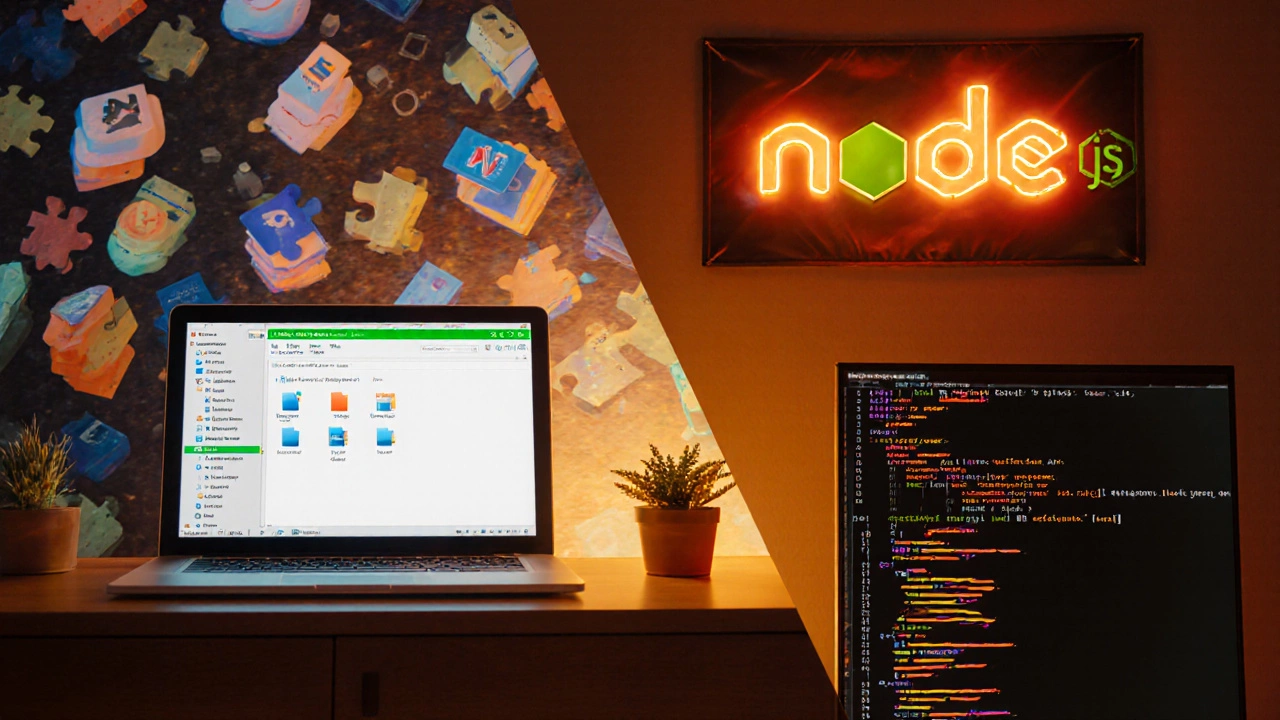Server-Side Language Decision Matrix
Answer the following questions to get a recommendation on which server-side language best suits your project needs.
Project Size
Team Expertise
Performance Needs
Hosting Environment
Recommended Language
Why This Recommendation?
Whenever a new developer or a seasoned engineer asks, “Is there anything better than PHP?” the conversation usually spirals into a list of buzz‑words, hype cycles, and personal preferences. The real answer depends on what you need to build, the team’s skill set, and the resources you have on hand. This guide unpacks the strengths and weaknesses of PHP, lines up the most talked‑about alternatives, and gives you a decision matrix you can actually use on a project.
When we talk about PHP is a server‑side scripting language that powers over 78% of the web, known for its ease of deployment and massive ecosystem of frameworks and CMS platforms. It debuted in 1995 and has evolved through versions 5, 7, and the recent 8.x releases that bring JIT compilation and typed properties. Its ubiquity means you can find a cheap shared host for a few dollars a month, but the same ubiquity sometimes fuels the myth that it’s outdated.
Why PHP Still Holds Its Ground
Before chasing “better” options, consider why PHP remains the go‑to language for millions of sites:
- **Wide hosting support** - Almost every web host offers PHP out of the box, often with one‑click installers for popular tools like WordPress.
- **Mature ecosystem** - Frameworks such as Laravel provides elegant syntax, built‑in ORM, and an active community that ships packages daily.
- **Fast learning curve** - The language’s syntax resembles C and Perl, making it approachable for beginners.
- **Large community** - Over 1.5 million questions on Stack Overflow and countless tutorials mean help is never far away.
- **Performance improvements** - PHP8’s JIT engine narrows the gap with compiled languages for many workloads.
Common Complaints About PHP
Every technology has its pain points. For PHP, developers often mention:
- **Inconsistent function naming** - Functions like
array_mergeandstr_replacefollow different conventions, leading to a learning curve for tidy code. - **Security missteps** - Legacy code bases sometimes expose vulnerabilities because older versions lacked strict typing.
- **Runtime errors** - Without type hints, certain bugs only surface at execution time, which can be frustrating in large code bases.
- **Comparison with modern stacks** - Frameworks built on JavaScript or Go often tout “single‑language full‑stack” advantages that PHP can’t match without extra tooling.

Top Contenders That Claim to Be “Better”
Below are the most common alternatives developers look at when they wonder if there’s a superior option.
Node.js is a JavaScript runtime built on Chrome’s V8 engine that lets you run JavaScript on the server, enabling full‑stack development with a single language. It shines for real‑time apps and micro‑services.
Python is a high‑level, readable language widely used for web development (via Django or Flask), data science, and automation. Its clean syntax and extensive libraries attract startups and research teams alike.
Ruby on Rails is a convention‑over‑configuration web framework that emphasizes developer happiness and rapid prototyping. It favors opinionated structure, which can speed up initial builds.
Go (or Golang) is a compiled language designed by Google for simplicity, concurrency, and performance in cloud‑native services. Its static binaries simplify deployment.
.NET is a Microsoft‑backed framework that supports C#, F#, and Visual Basic, offering a rich set of libraries for enterprise‑grade web applications. Recent open‑source moves make it cross‑platform.
Java is a long‑standing, strongly typed language with a robust ecosystem (Spring Boot, Jakarta EE) that powers large‑scale, high‑availability systems. JVM performance and tooling are battle‑tested.
Side‑by‑Side Comparison
| Language / Framework | Performance | Ecosystem & Packages | Learning Curve | Hosting Cost | Typical Use Cases |
|---|---|---|---|---|---|
| PHP (Laravel) | Good - JIT in 8.x narrows gap | Massive (Composer, Packagist) | Low - familiar syntax | Very low - shared hosting everywhere | CMS, e‑commerce, small‑to‑medium SaaS |
| Node.js (Express) | High - non‑blocking I/O | Huge (npm, Yarn) | Medium - async patterns | Low‑moderate - many PaaS options | Real‑time apps, APIs, micro‑services |
| Python (Django) | Moderate - interpreted, but fast dev | Extensive (PyPI) | Low - readable syntax | Moderate - need WSGI servers | Data‑driven sites, rapid prototypes |
| Ruby on Rails | Moderate - comparable to Django | Rich (RubyGems) | Medium - “Rails magic” learning | Moderate - VPS or cloud | Startups, MVPs, content platforms |
| Go | Very high - compiled, native concurrency | Growing (Go modules) | Medium - strict typing | Low‑moderate - static binaries simplify hosting | Micro‑services, high‑throughput APIs |
| .NET (C#) | High - JIT + ahead‑of‑time options | Broad (NuGet) | Medium - C‑style syntax | Moderate - Azure-friendly, cross‑platform now | Enterprise portals, APIs, desktop apps |
| Java (Spring Boot) | High - mature JVM optimizations | Extensive (Maven, Gradle) | Medium - verbose but well‑documented | Moderate - need JVM containers | Large‑scale, transaction‑heavy systems |
When to Stick With PHP
If your project already uses a CMS like WordPress, a shopping cart such as Magento, or a framework you love (Laravel, Symfony), the migration cost often outweighs performance gains. PHP shines when you need:
- Fast provisioning on cheap shared hosts.
- Access to a massive library of ready‑made plugins.
- Simple CRUD apps where development speed matters more than raw throughput.
- Team members who already know PHP basics.
In those scenarios, focusing on modern PHP practices-type declarations, proper dependency injection, and using Composer for packages-will give you a solid, maintainable code base without a full rewrite.
Checklist for Choosing a Server‑Side Language
- **Project size** - Small blogs vs. enterprise systems.
- **Team expertise** - Which language does the majority already know?
- **Performance needs** - Real‑time sockets, heavy computation, or typical request‑response?
- **Hosting environment** - Do you need ultra‑cheap shared hosting or are you on Kubernetes?
- **Third‑party integrations** - Specific SDKs or APIs might favor one ecosystem.
- **Future scalability** - Will the app grow into a micro‑service architecture?
Answering these questions helps you decide whether PHP alternatives truly bring value or if PHP itself still fits the bill.
Frequently Asked Questions
Is PHP still relevant in 2025?
Yes. Over 80% of the web still runs on PHP, and the language’s recent updates (PHP8.3) add JIT, typed properties, and improved error handling. Its dominance in CMS platforms ensures a steady demand for developers.
When should I choose Node.js over PHP?
Pick Node.js when you need real‑time communication (chat, live dashboards), want a single language across client and server, or plan to build micro‑services that benefit from non‑blocking I/O.
Can I migrate a WordPress site to another language easily?
Migrating WordPress itself is hard because the core and plugins are tightly coupled to PHP. You can rebuild the site using a headless approach-fetch data via the WordPress REST API and render it with another backend-but that’s essentially a rewrite.
Is Go faster than PHP for typical web traffic?
For raw CPU‑bound tasks, Go’s compiled binaries beat interpreted PHP by a large margin. However, for standard page rendering with a database, the difference is often negligible if you use PHP’s opcode caching and a modern web server.
What’s the biggest advantage of Django over PHP frameworks?
Django offers a “batteries‑included” philosophy with built‑in admin, ORM, and authentication, all written in Python’s clean syntax. It also integrates naturally with data‑science libraries, making it a top choice for data‑heavy applications.
